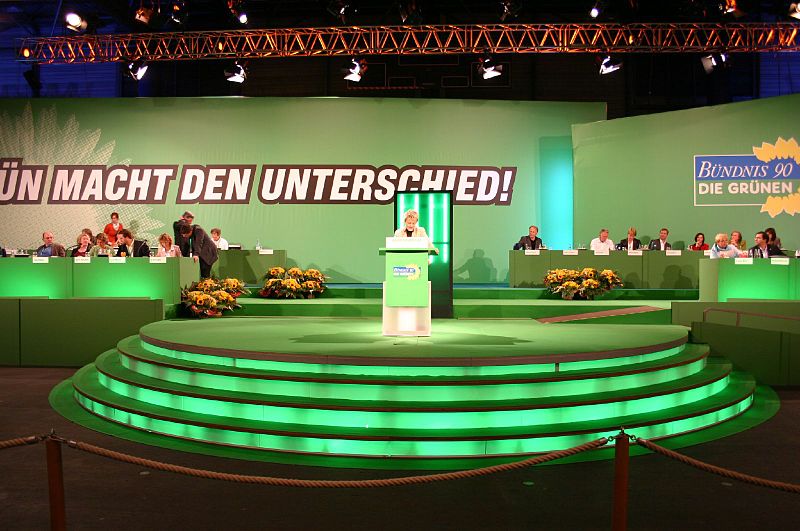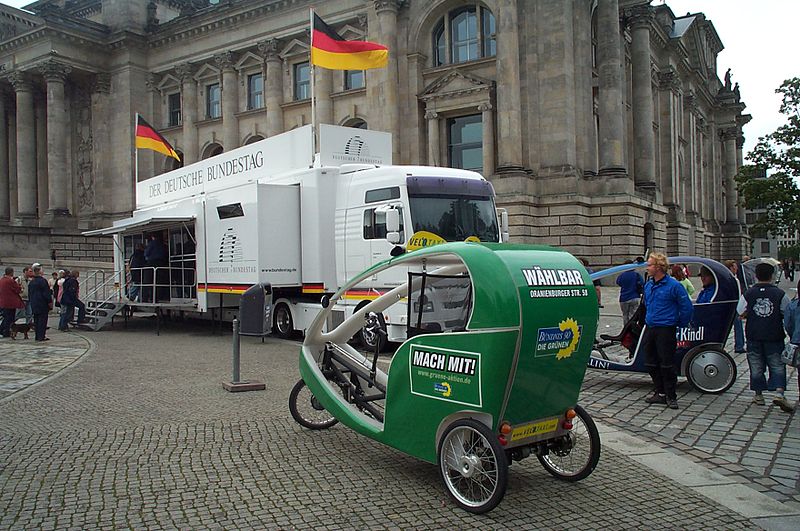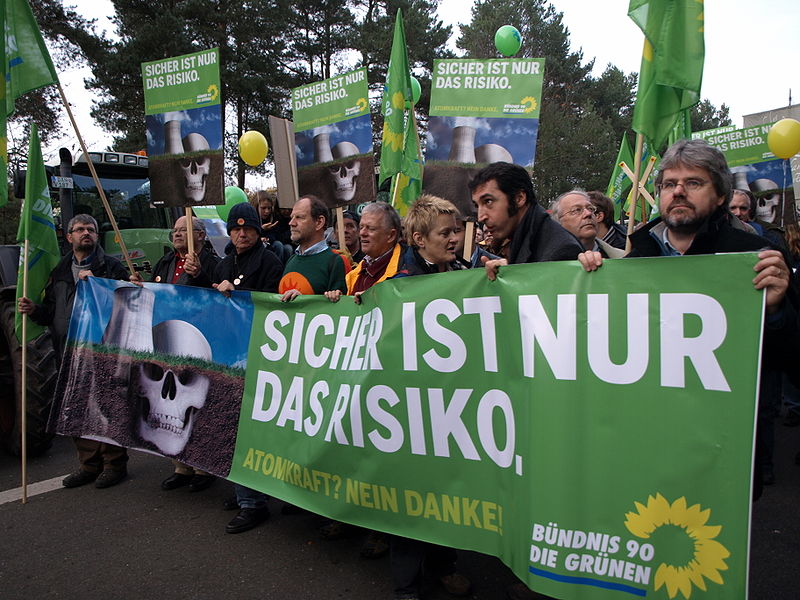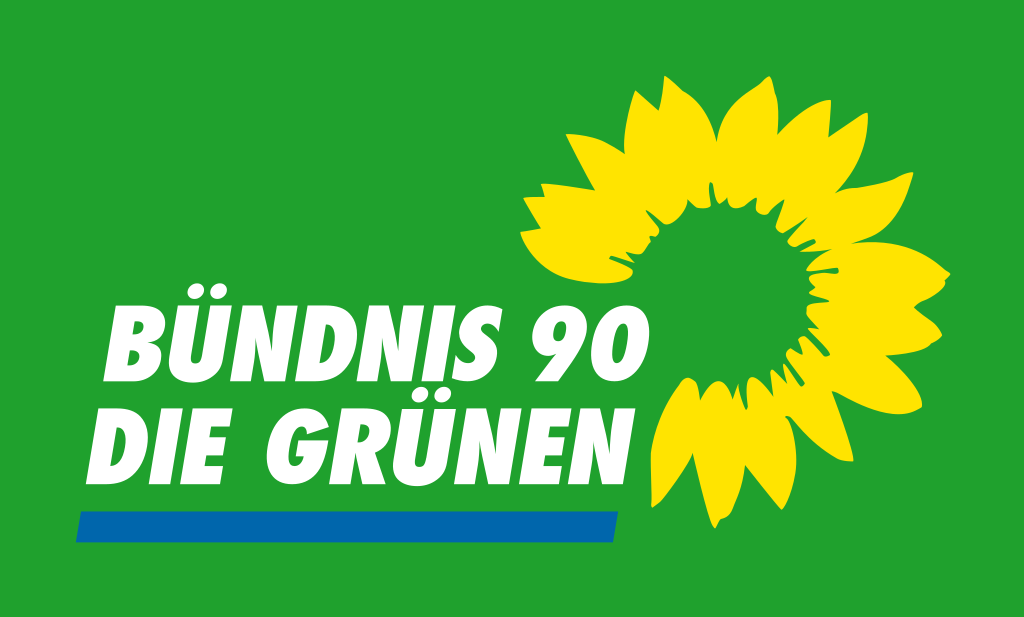With the next federal election to the Bundestag on 26 September 2021 only seven months away, the German Greens are preparing for a possible return to the federal government and a coalition with the CDU/CSU, Chancellor Angela Merkel's party alliance. Founded 41 years ago out of the environmental, women and anti-war movements, the party has long since become a modern bourgeois liberal party of the 21st century, eclipsing the traditional bourgeois liberals of the FDP.
The Greens have gained tremendous political importance in Germany in recent years. While other parties are shrinking or stagnating, they have a continuing influx of members and now for the first time count over 100,000 members. According to election polls, they are the second strongest party at the federal level, aiming to enter the federal government after almost 16 years in opposition. Current polls give the Greens between 17 and 20 percent, while the SPD is hovering between 15 and 17 percent. Merkel's CDU/CSU is currently between 33 and 27 percent. Thus, on the basis of German proportional representation, a “Black-Green” coalition would also be the most stable constellation arithmetically. Of course, all these forecasts are conditional.
It is not only for these reasons that Marxists need to look more closely at what the Greens are all about. This party and its youth organisation Green Youth play an important, often leading role in environmental movements like Fridays for Future. We need to pay much more attention to this party in order to be able to determine its future role in German politics.
Where do the Greens come from?
The Greens (Die Grünen) were founded in 1980 by elements of bourgeois environmental activists and the student movement, including ex-Maoists, ex-Mandelites and so-called “Spontis” (ultra-lefts who emphasised ‘spontaneous movements of the masses’). An impetus also came from the policies of the then-coalition of the SPD and the liberal FDP. SPD Chancellor Helmut Schmidt, a right-wing social democrat, emphatically supported nuclear power plants and medium-range nuclear missiles on US Army bases in Germany, which triggered a large protest movement at the time.
In the initial founding period of the Greens, there were strong conflicts between left-wing members and the conservative wing of the bourgeois ecologists. At the founding party conference in 1980, the “ecosocialists” prevailed. This led to a small split and the founding of the more conservative ÖDP, which still has municipal bases here and there in Bavaria.
Despite the initial dominance of forces calling themselves socialists, the Greens adopted a petty-bourgeois radical-democratic basic programme in 1980. The protection of small business, the peace movement and environmental issues were their primary points of demarcation from social democracy and the parties of the bourgeois camp.
Over time, the moderate so-called “realo” wing prevailed over the somewhat more radical so-called “fundamentalist“ or “fundi” wing. The Greens quickly opened up to coalitions at a municipal, state and federal level, initially predominantly with the SPD. The first “Red-Green” coalition in 1985 in Hesse became a milestone. The left wing, around people like Jutta Ditfurth, put forward the beginning of a class standpoint in 1987. When Ditfurth stood as a top Green candidate in the federal election, she made the then SPD leader Johannes Rau look insipid. She split from the party in the early 1990s, and the leaders of the “realo” wing around people like Joschka Fischer and Daniel Cohn-Bendit finally gained dominance over the party.
Federal Government 1998-2005
From 1998 to 2005, the Greens were part and parcel of the coalition government with the SPD under Chancellor Gerhard Schröder and Vice-Chancellor Joschka Fischer at the federal level for two election periods. In this way, they also share the blame for the attacks on the state pension (Riester), the Agenda 2010 with the notorious Hartz IV legislation, the pressure to cut and privatise the health system and a more aggressive German foreign policy with the active participation of the Bundeswehr in international wars.
After 9/11, the Schröder-Fischer government took part in the military operations in Afghanistan and the Horn of Africa. In addition, Germany participated in the bombing of Yugoslavia by NATO in 1999 with massive damage to the civilian population.
 The Greens project an ecological, pro-migrant, cosmopolitan image, but what is their real history and role in German politics? / Image: Tillwe
The Greens project an ecological, pro-migrant, cosmopolitan image, but what is their real history and role in German politics? / Image: Tillwe
For tactical reasons, Schröder and Fischer in the election year 2002 invoked the “German path” as an alternative to “American warmongering” in Iraq and described Germany as a “peace power”. This did not change the fact that Germany indirectly supported the war against Iraq in 2003 with overflight rights and logistical aid. After these years in government, any major and relevant residual opposition to social cuts and militarism within the Greens was broken.
The 1980 manifesto excluded any military intervention and called for the dissolution of NATO. Yet in 2020, the Greens adopted a new manifesto for the third time. In it, military operations are described as an “extreme means” that can be necessary, the Bundeswehr is also seen as a “necessary means of state and international security policy” and it is said that Germany must be “relied upon” as an international alliance partner. Despite criticism, NATO is now seen by the Greens as an “indispensable actor to guarantee Europe's security.”
To this day, the Greens feed on their reputation as a “progressive civil rights party” because they had already spoken out in favour of civil and voting rights for immigrants and easier naturalisation for migrants in the 1980s, long before the SPD did. The Greens have been able to distinguish themselves as “anti-AfD", and have built a reputation as a “consistent pro-refugee party”. This, combined with their strong adherence to identity politics means they are seen as a major political enemy by extreme right-wing forces. This helps give them a “progressive” and “cosmopolitan” image.
Likewise, the Greens benefit greatly from the increasingly important environmental issue. For example, the nuclear disaster in Fukushima, Japan, at the beginning of March 2011 suddenly gave a strong tailwind for the Greens in the elections in Baden-Württemberg, Rhineland-Palatinate and Hesse at that time. In Baden-Württemberg, the crazy real estate, railway station and construction project “Stuttgart 21” gave them an additional boost. And through their strong intervention in FFF, they were able to greatly increase their popularity among the youth.
Growing membership and influx of careerists
These are all factors that led to a sharp increase in membership from 2017, making the Greens now the second strongest party on the electorate plane. The Greens have almost doubled their membership base since 2015. Any party that is on the upswing becomes a desirable target for careerists, because it is possible to get well-remunerated mandates and posts in the state apparatus in a fairly short period of time. Though by no means every new Green member can be labelled careerist, history has shown time and again that even the strongest convictions are not immune to later career ambitions and opportunism.
According to sociologists, the Greens are considered the party of left-liberal academics. They are by far the party with the highest proportion of university graduates in their membership and support base. 72 percent of members have a (technical) university degree.
Luisa Neubauer, a member of the Green Party and Green Youth, has emerged in the media as the current face of FFF in Germany. This is not a coincidence or an isolated case, because the Greens are trying with all their might to appropriate the movement primarily as an electoral movement and recruitment field. The Green leadership is trying with all its might to suppress the anti-capitalist forces systematically. Comrades of the IMT in Upper Bavaria have experienced that the regional Greens would rather split FFF demos than allow anti-capitalist slogans to be put forward.
In 2011, ex-Maoist Winfried Kretschmann became the first Green president in one of the 16 federal states. He has been in office in the south-western state of Baden-Württemberg since then. Since then, Kretschmann has come to terms very well with the big bourgeoisie in Baden-Württemberg, which is dominated by corporations such as Daimler, Porsche, Audi and Bosch. The regional employers' association Südwestmetall was one of the first groups of big business to regularly transfer large donations to the Greens.
However, the most important business lobby and pressure group within the Greens is the “Bundesverband Erneuerbare Energie” (Industrial Federation for Renewable Energy). This lobbying umbrella organisation displays enormous financial commitment to the Greens. Some Green ex-politicians are already working for this association as consultants and employees.
The Greens' new position in the state of Baden-Württemberg, with its strong motorcar industry, has made the party increasingly attractive to big business. This can be seen in ever-larger sums in sponsorships at party conventions and large donations.
Sponsorship of events:
Green Federal Conference 2013 - 82,800 euros
Green Federal Conference 2018 - 173,513.85 euros
Green Federal Conference 2019 - 277,482.97 euros
Major big donations to Greens:
2013 - 60,000 euros, Südwestmetall only
2018 - 258,501 euros
2019 - 335,001 euros
Quite clearly, from 2018 to 2019, a sharp jump in funding from big business can be seen for the Greens.
Second pillar of the ruling class
The Greens are now clearly being built up by the bourgeoisie as an indispensable second pillar of the bourgeois parties. The signs are clearly pointing to a “Black-Green” alliance of the Green with the post-Merkel CDU/CSU. The supposed “people's parties” and pillars of the “grand” coalition, CDU/CSU and SPD, no longer have a stable majority together, according to the polls. Likewise, the SPD is anaemic and can hardly mobilise people. Even the classic middle-class government constellation of CDU/CSU and FDP, which was in office for 33 of the 72 years of the Federal Republic of Germany, is unlikely to get enough votes cast in the coming election. On the other hand, the Greens, as a rising force, are just what the CDU/CSU needs.
The Green leadership is also ready for this. While the right wing of the Left Party (DIE LINKE) dreams of a coalition with the SPD and the Greens, Green Party leader Robert Habeck has clearly shot down hopes for a “Green-Red-Red” arrangement. In his book Von hier an anders (From here on differently) he justifies this with the “drifting apart of the milieus", arguing that a Green-Red-Red coalition would further disrupt the cohesion of society. Instead of a “revolution", a “new foundation of trust” is necessary, says Habeck.
 The Greens are now clearly being built up by the bourgeoisie as an indispensable second pillar of the bourgeois parties / Image: Kaihsu
The Greens are now clearly being built up by the bourgeoisie as an indispensable second pillar of the bourgeois parties / Image: Kaihsu
For all these reasons, a “Black-Green” federal government is very possible as the outcome of the Bundestag elections in September. The Greens have not been in the federal government for almost 16 years and present themselves in their PR as a “fresh", “progressive", “ecological” and “anti-racist” force. Young people under the age of 30 generally cannot remember the role of the Greens in the Schröder-Fischer government and often harbour illusions in them.
The model for a Black-Green alliance at the federal level is the state of Hesse, where a traditionally right-wing nationalist CDU has governed peacefully and quietly with the Greens for seven years. Hesse's deputy prime minister and transport minister Tarek Al-Wazir (Greens) is currently showing the ruling class that he is a reliable representative of the interests of capital as the enforcer of the deforestation of the Dannenröder Forest ("Danni"), which was pushed through with brutal police violence. He would certainly be the same in a federal cabinet. Since last autumn, logging has been underway in the ecologically valuable Danni, which also serves as a drinking water reservoir for a vast area, for the construction of a privately financed motorway project. This has triggered a strong protest movement.
As a governing party, the Greens will certainly try to distinguish themselves with token gestures and flagship projects that impress a part of their base and promote green capitalists, eco-farmers, “regional cycles", bicycle lobbies and identity politics. But the erstwhile eco-party will once again turn out to be a great traitor to its own ecological ideals in government. Effective climate protection and capitalist interests are diametrically opposed and incompatible.
When Green leaders attain lucrative government positions, they know only one moral: preserve their posts and privileges. If they ruthlessly uphold capitalist interests in such disputes as the one over the “Danni", and prove themselves tough and immune to pressure from below, then a lucrative post in big business and lobbying associations awaits them even after they leave top political offices. This is shown by the careers of former Green government ministers and state secretaries such as Joschka Fischer, Rezzo Schlauch, Margareta Wolf, Matthias Berninger. All of them subsequently became highly remunerated lobbyists for well-known capital groups and international corporations.
Annalena Baerbock, the current co-chair of the Green Party, already got more applause than speakers from other parliamentary parties at the congress of the Federation of German Industries (BDI) in June 2019. Yet because no election can be won with the applause of the capitalists alone, the campaign strategists of the ex-ecological party are busily tinkering with a “social democratic” image in the burgeoning election campaign.
The demand for the abolition of “Hartz IV” sanctions, for example, is intended to appeal to people who, as a result of the lockdown, are suddenly and unexpectedly threatened with being thrown into the bureaucratic nightmare of social welfare offices and job centres. From the point of view of the Green bureaucracy, this includes self-employed people and tradespeople, who will be hit hard by the lockdown, who will not be able to claim short-time work allowances because they do not qualify as employees, and who could therefore find themselves financially on the brink. Hartz IV was a centrepiece of the counter-reforms of the Schröder-Fischer government and has led to the massive impoverishment of the unemployed and the expansion of casual labour.
“Social democratic” image
Certainly, the Greens represent nothing other than a modern liberal bourgeois party of the 21st century. But in order to conceal their complicity in social cuts during seven years of “Red-Green” federal government from 1998 to 2005, which linkers to some extent in the public perception, the PR and electoral strategists now point to a supposed “closeness to the trade unions” and the labour movement. In this way, they want to take a bite out of the weakening SPD in its own field. For the SPD leadership has always prided itself as a moderator and mediator with the trade union apparatus.
 Despite the illusions they enjoy, the Greens represent nothing other than a modern liberal bourgeois party of the 21st century / Image: Paula Schramm
Despite the illusions they enjoy, the Greens represent nothing other than a modern liberal bourgeois party of the 21st century / Image: Paula Schramm
At the beginning of 2021, Green Party leader Robert Habeck and Rainer Hoffmann, chairman of the trade union confederation DGB, published a joint article in the FAZ entitled ‘Die Linke droht sich im Widerspruch zu verhedrdern’ (‘The Left is threatening to get tangled up in contradictions’). In it, they rejected a wealth tax and argued for more public debt in times of crisis.
Another matter could serve as a beacon for the Greens in the election campaign to claim a supposed “closeness to the trade unions”. Frank Bsirske (68), who had been the leader of Germany's second-biggest union ver.di, and who has been a member of the party since the 1980s, is standing for the Greens for the Bundestag in constituency no. 51 (Wolfsburg-Helmstedt), which is dominated by the big Volkswagen factory in Wolfsburg. He is aiming to win the seat directly and wants to get a safe, top position on the party's slate for the state of Lower Saxony.
Some rumours say that Bsirske wants a second career in his old age – not as a backbencher, but as a federal labour minister. In almost two decades as ver.di leader, the eloquent Bsirske has known how to present himself as a committed “buddy guy”. His role in the trade union apparatus, in collective bargaining rounds and in many supervisory boards of well-known companies was to uphold the status quo, to the exact same extent as other top leaders in the labour aristocracy.
But Bsirske also has a feel and flair for moods. In September 2019, for example, he called on the members of his union to participate in the climate strikes of the FFF movement, but “only outside working hours", as he emphasised. Discussions about creative ways to make a contribution to the climate strike “quite legally” in the factories, for example, through work meetings, were far from his mind.
Greens favour British-type rail privatisation
The Greens still live off their reputation as supposedly consistent advocates of a fundamental change in transport policies and as champions of cycle paths and public transport. However, their concrete policies in Hesse and Baden-Württemberg and other federal states where they are involved in governments look quite different.
The fact that the Greens do not deliver on their slogans is exemplified by a look at a new paper by the Green parliamentary group in the Bundestag on the future of German railways. Verbally, the paper rejects the privatisation of Deutsche Bahn (DB), which is still 100 percent owned by the federal government. The attempt to sell DB shares by means of an IPO failed in October 2008 due to the crisis of world capitalism. Since then, no serious political actor wants to get their fingers burnt with this irritating topic. Moreover, private investors are not interested in share packages, but in profits and cherry-picking. Corporations such as Siemens, Knorr-Bremse, Stadler and internationally operating private railways such as National Express, GoAhead and others have their eyes on repair works, other sub-operations and tenders for public transport.
Anyone who delves deeper into the matter and examines the Greens’ paper quickly comes across the strategy of creeping privatisation through the backdoor, as the BDI, CDU/CSU and FDP have been demanding for decades. The federally owned DB is to be completely broken up and split up. The railway network and infrastructure are to be separated and transferred to a public-law institution (AöR), which will be massively financed from public funds. The DB transport subsidiaries in charge of passenger and freight transport, on the other hand, are to be organised in a GmbH (limited liability company). This facilitates a material privatisation. Supported by public vehicle pools, private capital groups are to be increasingly involved in long-distance passenger transport by means of invitations to tender.
This is already the case in regional transport, where DB's market share has almost halved in two decades in favour of private groups. In the case of the Berlin S-Bahn (suburban railways) and in the federal states, Green politicians are the pioneers of tendering and thus of creeping privatisation. The many negative experiences are nowhere questioned in the Greens’ paper.
Their model is in effect based on the current situation in Britain, the European pioneer of railway privatisation, where the loss-making network is in effect public, while the prime assets in the transport and service sector are controlled by private companies. This puts the Greens in line with business associations and other bourgeois parties. With a possible Black-Green federal government, such a serious push towards filleting, dismantling and privatising the railways on the British model is getting closer.
In this way, the Greens are betraying their own (former) ecological aims. A railway system based on private profit and dismantled and fragmented train operation companies will never exploit the advantages of rail transport. The rail sector is bound to lose out in the competition with other modes of transport.
This example also undermines the reformist hope that the coronavirus and economic crisis could lead to a change of course in economic policy away from “neoliberalism” and orgies of privatisation. It is true that there are clear tendencies towards state interventionism in the crisis. But the creeping privatisation in many sectors continues. There is no turning away from the privatisation policy in sight.
All this also offers new opportunities for radicalisation of youth around FFF. The Greens' claim to leadership has already been strongly criticised in many places. There are good opportunities for Marxists in the near future to intervene with radical socialist ideas.
Here and there, more radical environmental activists will try to tap into the Green voter potential in regional and local elections. But a major breakthrough is not to be expected.
Quite a few young people who become radicalised over the environmental question will very quickly draw socialist conclusions based on their experiences and realise that this is a class issue. To address it, we do not have to take the diversions via a supposed “ecosocialism”. Marx, Engels, Bebel and other pioneers explained the close connection between environmental destruction and the capitalist mode of production as early as in the 19th century. Only a worldwide democratic and socialist planned economy led by the working class can stop the global climate catastrophe, and halt and gradually reverse its effects.

